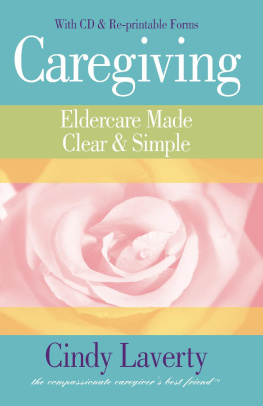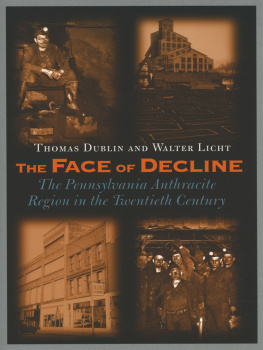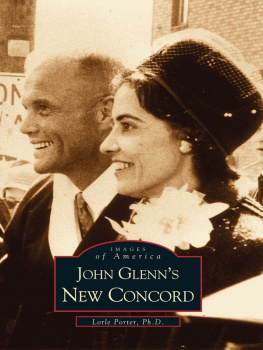Medical Caregiving and Identity in Pennsylvanias Anthracite Region, 18802000
Library of Congress
Cataloging-in-Publication Data
Weaver, Karol K. (Karol Kimberlee)
Medical caregiving and identity in Pennsylvanias anthracite region, 18802000 / Karol K. Weaver.
p. cm.
Includes bibliographical references and index.
Summary: Examines folk songs, patent medicine advertisements, oral history interviews, ghost stories, and jokes to show how over the course of the twentieth century the men and women of the anthracite coal region of Pennsylvania crafted their gender and ethnic identities via the medical decisions they made.Provided by publisher.
ISBN 978-0-271-04878-9 (cloth : acid-free paper)
1. MedicinePennsylvaniaHistory19th century.
2. MedicinePennsylvania History20th century.
3. Coal minersMedical carePennsylvaniaHistory.
4. Medical carePennsylvaniaHistory.
5. Traditional medicinePennsylvaniaHistory.
6. Coal minersPennsylvaniaSocial conditions.
7. Coal mines and miningSocial aspectsPennsylvania History.
8. Sex rolePennsylvaniaHistory.
9. Ethnicity PennsylvaniaHistory.
10. PennsylvaniaSocial conditions.
I. Title. R313.W43 2011
610.9748dc22 2011003077
Copyright 2011
The Pennsylvania State University
All rights reserved
Printed in the United States of America
Published by
The Pennsylvania State University Press,
University Park, PA 168021003
The Pennsylvania State University Press
is a member of the
Association of American University Presses.
It is the policy of The Pennsylvania State University Press to use acid-free paper. Publications on uncoated stock satisfy the minimum requirements of American National Standard for Information SciencesPermanence of Paper for Printed Library Material, ANSI Z39.481992.
This book is printed on Natures Natural, which contains 50% post-consumer waste.
For Mommy and Daddy
CONTENTS
I want to thank the following people for their professional guidance and assistance: Kathryn Yahner, Janet Lindman, Rachel Batch, Brian Black, Jean Soderlund, and the audiences at the meetings of the Pennsylvania Historical Association and the American Historical Association. I received excellent help from the student researchers at Susquehanna University; Amanda Hawk, Sarah Kern, and Holly Moncavage did superb work. This book was supported with money from Susquehanna Universitys Faculty Scholarship and Development Committee, Provosts Office, and Department of History. Portions of the book have appeared previously in Der Reggeboge and Pennsylvania History: A Journal of Mid-Atlantic Studies.
The researching and writing of this book were pleasures, acts of love. Its genesis came forth from my mothers ability to tell a good story. Having been schooled by an expert storyteller, I learned to appreciate the tales that others had to tell me. I cant thank her, my father, and my childhood neighbors enough for the wisdom they shared with me. The beauty and wealth of the coal region continue to inspire me. As always, my sisters Krisa and Kaleen were there. My husband, Paul, has always listened, and my children, Jonah and Pearl, are my greatest joys. My mother and father did not live long enough to see this book in print. Their generosity and love are boundless. I dedicate this book to them.
Growing up in the anthracite coal region of Pennsylvania, I heard stories about my nonna (grandmother) offering medical services to her neighbors. My mom told me that my nonna went up the bush to collect greens, which she then boiled into a tea and distributed to neighbors suffering from infections. My mother also said that my nonna walked miles to care for a friend dying from cancer. She tended sick neighborhood children and, in so doing, comforted their overworked mothers and fathers.
There were many caregivers like my immigrant grandmothermen and women, educated and uneducated, foreign born and Americanwho willingly and compassionately served the medical needs of their own families and those of their neighbors. In the pages that follow you will learn that the simple story my mother told me demonstrated that the way one takes care of the body and the soul (whether your own or anothers) defines who one is and who one can become.
The history of medical caregivers like my nonna shows that medicine shapes ones identity. Immigrants and native-born Americans in the anthracite coal region of Pennsylvania sought medical care from neighborhood women, Pennsylvania German powwowers, American physicians, and immigrant doctors. While most immigrants ultimately abandoned their medical customs, Pennsylvania Germans retained their traditional medical system because of their creation of a strong ethnic identity. Similarly, Italian Americans remained committed to their medical customs because of their ability to honor their Italian ancestry while simultaneously adhering to American values. Over time, biomedicine became the hallmark of an assimilated American.
The influx of new immigrants from eastern and southern Europe to Pennsylvania was immense. Between 1899 and 1914, more than 2.3 million Moreover, class distinctions based on where one figured into the coal economy divided residents. The area also was a diverse blend of ethnicities and religions. Descendants of English, Welsh, German, and Irish immigrants inhabited the area, as did the new immigrants. Catholics outnumbered both Protestants and a small community of Jews. These ethnic, religious, and class divisions affected the type of medical care provider a coal region resident chose.
Neighborhood women were medical caregivers who lived and worked in the anthracite coal region. They provided domestic medicine, which meant they used both homemade and store-bought remedies, performed minor surgery, served as midwives, and offered spiritual and emotional comfort to their clients. Residents of the coal communities recognized these women as medical caregivers and sought them out when they were ill. Both American-born women and new immigrants served as community caregivers, and their training ranged from practical experience to formal education. Using domestic medicine, these women extended their maternal roles beyond the confines of their own homes and out into the homes of their neighbors and into the corner stores that anchored that regions neighborhood. Yet as the maternal roles of women changed during the second half of the twentieth century, much of the work once completed by neighborhood women came to be done by family doctors.
Neighborhood women generally offered care to other women and to children. Men, especially miners, practiced medical self-helpthey took responsibility for their physical problems. Specifically, they employed alcohol, tobacco, and patent medicines to deal with black lung and with the wounds they incurred while working. They obtained these items from local taverns and corner stores and via mail order companies. Their medical independence and the spaces where they obtained medical relief reflected the types of masculine behavior expected of men and boys in coal country. Although alcohol and tobacco were recognized elements of the American pharmacopoeia, miners were criticized for their use of these items, charged with intemperance and economic wastefulness, and their medical needs, especially in regard to black lung, were ignored or dismissed.










